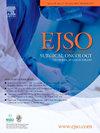术中手术导航改善颅面前部晚期恶性肿瘤的切缘状态:一项前瞻性观察性研究,系统回顾文献和荟萃分析。
IF 3.5
2区 医学
Q2 ONCOLOGY
引用次数: 0
摘要
目前的科学证据表明,手术导航(SN)有助于改善鼻鼻部和颅面外科手术的肿瘤预后。本研究探讨术中SN的可行性及其在改善鼻窦和颅面肿瘤手术治疗效果中的作用。这项前瞻性研究比较了导航引导下鼻窦或颅面恶性肿瘤的手术与一对配对队列(1:2配对)的无SN手术患者。对文献进行了系统的回顾。35例接受导航手术的患者被纳入研究。配对对照组包括70例未行SN手术的患者。切缘状态分析显示,SN组切缘阳性率较低(p = 0.013),特别是pT4 (p = 0.034)、复发(p = 0.024)、高级别肿瘤(p = 0.043)和内镜辅助开放手术(p = 0.035)。术前平均时间在有无SN的情况下无显著差异(1.26 h vs 1.23 h, p = 0.445)。然而,与未使用SN的手术相比,使用SN的手术中位持续时间明显更长(8.10 h对6.00 h, p = 0.029)。meta分析共纳入209例患者;91例(43.5%)患者接受手术治疗。meta分析结果显示,使用SN后,负边际率有所改善(OR = 2.62;95%置信区间:1.33-5.17)。综上所述,术中SN有助于实现清晰的切缘切除,特别是在局部晚期肿瘤、复发、高度侵袭性组织学以及采用内镜辅助开放手术时。本文章由计算机程序翻译,如有差异,请以英文原文为准。
Intraoperative surgical navigation improves margin status in advanced malignancies of the anterior craniofacial area: A prospective observational study with systematic review of the literature and meta-analysis
The current scientific evidence suggests that surgical navigation (SN) can contribute to improve oncologic outcomes in sinonasal and craniofacial surgery. The present study investigated the feasibility of intraoperative SN and its role in improving the outcomes of surgically treated sinonasal and craniofacial tumors.
This prospective study compared navigation-guided surgery for sinonasal or craniofacial malignancies with a pair-matched cohort (1:2 matching) of patients operated without SN. A systematic review of the literature was performed.
Thirty-five patients who underwent navigation-guided surgery were included. The pair-matched control cohort included 70 patients operated without SN. The margin status analysis demonstrated a lower rate of positive margins (p = 0.013) in the SN group, especially in pT4 (p = 0.034), recurrent (p = 0.024), high-grade tumors (p = 0.043), and endoscopic-assisted open surgery (p = 0.035). The mean preoperative time did not show a significant difference between surgeries performed with or without SN (1.26 vs. 1.23 h, p = 0.445). However, surgeries utilizing SN had a significantly longer median duration compared to those without (8.10 vs. 6.00 h, p = 0.029). A total of 209 patients were included in the meta-analysis; 91 patients (43.5 %) underwent surgery with SN. The results of the meta-analysis showed an improvement in terms of negative margins rate with the use of SN (OR = 2.62; 95%-confidence interval: 1.33–5.17).
In conclusion, intraoperative SN can contribute to achieve a clear margin resection, especially in locally advanced tumors, recurrences, highly aggressive histologies, and when endoscopic-assisted open surgery is employed.
求助全文
通过发布文献求助,成功后即可免费获取论文全文。
去求助
来源期刊

Ejso
医学-外科
CiteScore
6.40
自引率
2.60%
发文量
1148
审稿时长
41 days
期刊介绍:
JSO - European Journal of Surgical Oncology ("the Journal of Cancer Surgery") is the Official Journal of the European Society of Surgical Oncology and BASO ~ the Association for Cancer Surgery.
The EJSO aims to advance surgical oncology research and practice through the publication of original research articles, review articles, editorials, debates and correspondence.
 求助内容:
求助内容: 应助结果提醒方式:
应助结果提醒方式:


